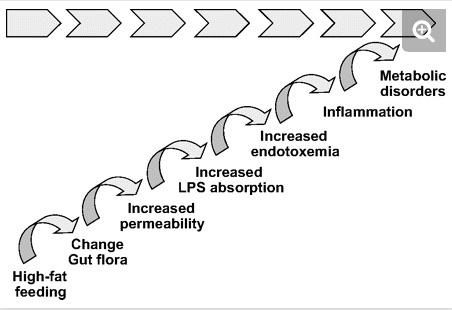Bifido spp. improves Glucose Tolerance
Dear Friends

High-fat diets increases insulin resistance (IR) and the risk of developing metabolic diseases such as obesity and diabetes.
Cani et al. (2007), Metabolic Endotoxemia Initiates Obesity and Insulin Resistance, describe their search for an inflammatory factor causative for the onset of insulin resistance, obesity, and diabetes. They identified bacterial lipopolysaccharide (LPS) as a major triggering factor.
In various research studies (using a rat research model), Cani et al. found that normal endotoxemia increased or decreased during the fed or fasted state, respectively. A 4-week high-fat diet chronically increased plasma LPS concentration two to three times, a threshold that they defined as metabolic endotoxemia. The immune system reacts vigorously to LPS in the plasma creating chronic inflammation and causing insulin resistance.
The consequence of insulin resistance will favor hyperinsulinemia and excessive hepatic and adipose tissue lipid storage. And, adipose tissue presents increased expression and content of pro-inflammatory cytokines such as TNF-a, IL-1 (3,4) and Il-6 (4).
Importantly, a high-fat diet for 4 weeks resulted in significant modulation of dominant bacterial populations within the intestinal microbiota. Shifting to a higher percentage of gram-negative bacteria over gram-positive bacteria. In particular they found a lowering of the gram-positive Bifidobacterial levels, which cause an increased opening within the tight junctions, allowing for more LPS from the gram-negative bacteria to pass into the plasma.
Cani et al. (2007a) found that adding inulin to the high-fat feed of the research animals, increased the Bifido levels in their colon, which tightened the junctions and reduced the LPS systemic levels.
Their conclusion: Bifidobacterium spp. significantly and positively correlated with improved glucose tolerance, glucose-induced insulin secretion and normalised inflammatory tone (decreased endotoxaemia, plasma and adipose tissue proinflammatory cytokines).
Food Science: Risk-Reduction of Metabolic Disease
Select from any one of the following Synbiotic products. They also can be alternated from dose to dose.
- Original Synbiotic– one tsp. daily
- Beta Glucan High Potency Synbiotic– one tbl. daily
- No. 7 Systemic Booster– one tsp. daily
All of these formulas contain ample amounts of organic chicory root derived inulin and the probiotic bacteria Bifido longum found in the research of Cani et al. to facilitate the reduction of entoxemia, and thereby reducing a contributing factor in obesity and diabetes.
Bibliography:
- Cani et al. (2009). Changes in gut microbiota control inflammation in obese mice through a mechanism involving GLP-2 driven improvement of gut permeability. Gut; 58(8): 1091-1103
- Cani et al. (2008). Changes in gut microbiota control metabolic endotoxemia-induced inflammation in high-fat induced obesity and diabetes in mice, Diabetes; 57:1470-8.
- Cani et al. (2007). Metabolic endotoxemia initiates obesity and insulin resistance. Diabetes; 56:1761-72.
- Cani et al. (2007a). Selective increases of Bifidobacteria in gut microflora improve high-fat-diet-induced diabetes in mice through a mechanism associated with endotoxaemia. Diabetologia; 50: 2374-83.
Sincerely yours,
Seann Bardell
We have developed our products based on scientific research and/or the practical experience of many healthcare practitioners. There is a growing body of literature on food based nutrition and supplements and their application in support of our health. Please use our products under the advisement of your doctor.
Green Facts:

|